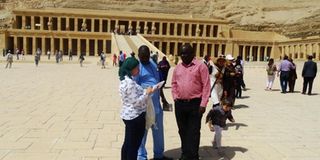Egypt: An open book of history

Tourists at the front yard of the Temple of Hatshepsut in Luxor, Egypt. Photos by Odoobo C. Bichachi
What you need to know:
WONDERS. Luxor stands head and shoulders above Egypt’s other towns for its sheer wealth of temples and tombs, writes ODOOBO C. BICHACHI.
Egypt brands itself as the “heart of Africa” but that is a misnomer. The more fitting tag should, perhaps, be Egypt is “an open book of history”.
Visiting the country that sits at the confluence of Africa, Asia and Europe in March this year and spending three weeks peeling open one page of human history after another was one of my most fulfilling moments of travel. Every turn was not just a story steeped in ancient history, but a marvel of human ingenuity.
Cairo Museum
First was the Cairo Museum, established in 1902 in the centre of the city of 20 million people. The imposing museum holds one of the biggest antique collections in the world – 120,000 pieces. Each piece – from the gold trinkets recovered from the tombs of the Pharaohs to the mummified bodies and gold-plated coffins they once lay in was a big lesson in humanity, its grandeur and its contradictions.
The towering pyramids
Then there was the visit to the Pyramids of Giza outside Cairo. Historians and archeologists have described it as one the Seven Wonders of the Ancient World. Built in 2580–2560 BC as the resting place of King Khufu, one of the greatest rulers of ancient Egypt, the visit to these great pyramids (three in total and the Sphinx) was enchanting not because of the indescribable interface with history but because I could tick off another accomplishment; touching the second of the Seven Wonders of the World. Earlier in 2003, I had occasion to visit the Taj Mahal in Agra, India and what a great feeling! The Taj Mahal was built to celebrate love while the Pyramids of Giza were built to celebrate death, two important aspects of life.

Luxor
But if indeed Egypt is an open book of history, then the centre of that book is Luxor. Located about 700km south of Cairo on the eastern banks of River Nile, the city was known as Thebes in ancient Greek literature.
Every corner of Luxor is rich in heritage dating back thousands of years. No wonder the city has the audacity to brand itself as “the tourism capital of the world”. The city was milling with tourists and tourist buses from one site to another. Its weather is great as it lies right at the Tropic of Cancer.
Temples and Valley of Kings
Right of the main driveway along the Nile River is the Great Temple of Amun at Karnak. The temple was buried by sediment from the Nile for years and when anthropologists unearthed its magnificent architecture.
Further outside the city across the western bank of the Nile are perhaps the most revealing heritage; the Valley of Kings and the Temple of one of the few female rulers of Egypt, Queen Hatshepsut.
The Valley of Kings is where the rulers of the middle empire were buried with tombs burrowed into the hills. The kings had learnt that pyramids did not preserve the remains of the kings for next life as they were susceptible and inviting to tomb robbers.
Fulfilment
Having watched many of these places on television documentary channels such as National Geographic and Discovery, it was fulfilling to be there in person; entering one chamber after another and witnessing the folly of human omnipotence.
But beyond the temples, Luxor has made great use of the Nile River with small and big, budget and luxury tourist laden boats filling the calm water of the river.
If life and time allows, I shall return to Luxor!
Banana island
If you have had your fill of temples and tombs for the day, there is no better way to relax in Luxor than to take a felucca ride to Banana Island. Five kilometres upriver from Luxor, this teeny palm-shaded island is the perfect chilled-out contrast to the history-filled treasures of the West and East Bank. Hop on a felucca in the late afternoon after a long day of temple and tomb viewing, and sit back to watch the Nile-side views as the boat captain raises the sail and you slide up the river.




